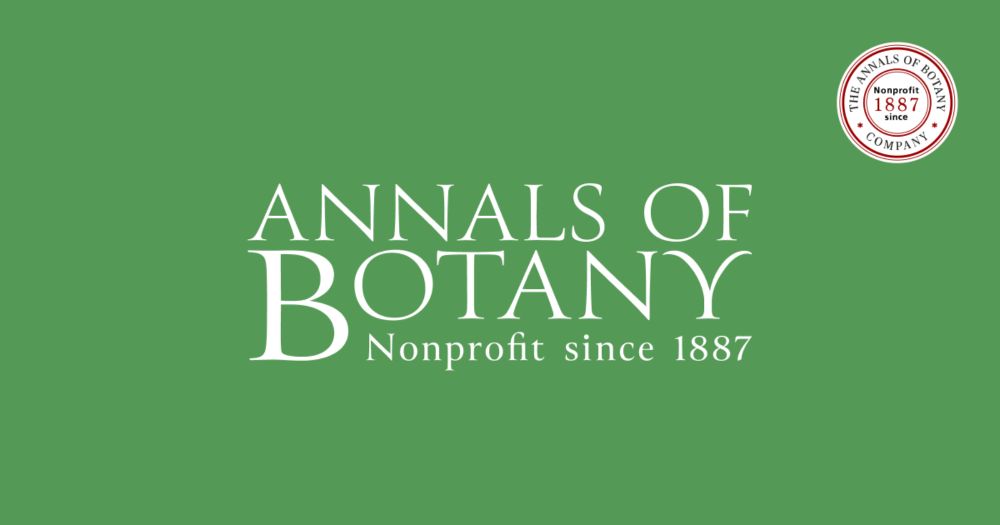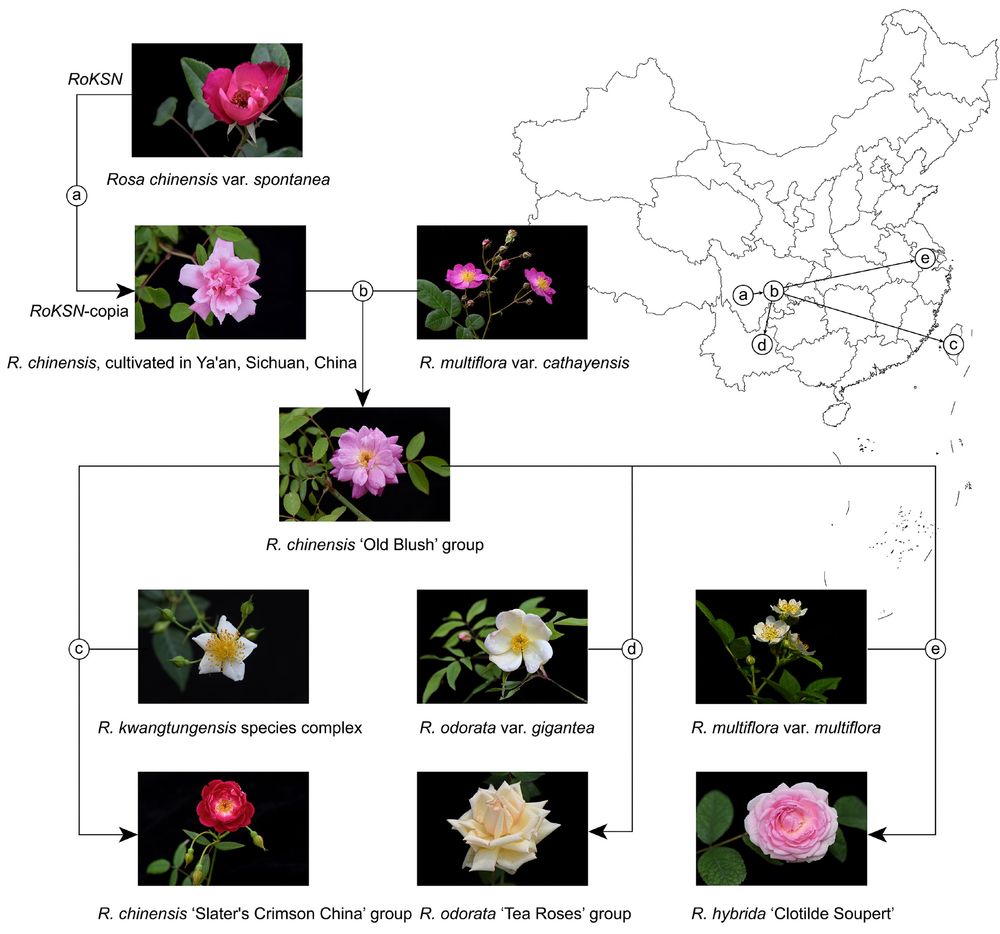
Rhinanthus minor in USA by Julie Travaglini / iNaturalist. CC-BY
Parasitic plants help build lignin deposits in host tissues
🌿 Now in @botany.one 🌿
botany.fyi/lq45ex
Full paper: doi.org/10.1093/aob/...
@annbot.bsky.social
International journal publishing novel and rigorous research in all areas of plant science, managed by the Annals of Botany Company, a not-for-profit educational charity.

Rhinanthus minor in USA by Julie Travaglini / iNaturalist. CC-BY
Parasitic plants help build lignin deposits in host tissues
🌿 Now in @botany.one 🌿
botany.fyi/lq45ex
Full paper: doi.org/10.1093/aob/...
🎉🆕📰🎉: Molecular polymorphisms of the nuclear and chloroplast genomes among African melon germplasms reveal abundant and unique genetic diversity, especially in Sudan
doi.org/10.1093/aob/...
🎉🆕📰🎉: Everchanging range: how the changing environment has influenced the genetic diversity and differentiation of an iconic North American palm species
doi.org/10.1093/aob/...

The team’s experience with Solanum shows how digital, user-friendly tools can open access to plant identification, helping both researchers and the wider community explore plant diversity. (8/8)
👉 doi.org/p8sx
#PlantTaxonomy #Biodiversity #Solanum #Botany #AoBpapers
Unlike traditional dichotomous keys (which can be long and rigid), multi-access keys:
🌿 Work with partial or vegetative material
🌍 Can be used online
⚙️ Are faster to build and update
📘 Can even precede full taxonomic treatments (7/8)

Figure showing the identification strategy for large plant genera, showing how Solanum species are gradually narrowed down using simple plant traits. The process starts with two easy-to-see features — the presence or absence of prickles and stellate (star-shaped) hairs — which divide the genus into four smaller groups worldwide: Group 1: no prickles, no stellate hairs Group 2: no prickles, with stellate hairs Group 3: with prickles, no stellate hairs Group 4: with prickles and stellate hairs After this first step, users can refine their search by adding geographic information and other vegetative or reproductive traits to identify a specific subgroup (called an infrageneric group). Once the correct group is found, users can continue identification at the species level using the online key (https://solanum-groups.identificationkey.org/mkey.html ) or other published taxonomic resources. The figure shows two examples from Solanum: the Petota group (wild potatoes) on the left and S. elaeagnifolium on the right. Note: the total number of species across the four initial groups is higher than the current number of recognized Solanum species because some species vary in these two first traits.
Why is this important? Because in Solanum, most groups and species are defined by multiple traits, not just one unique feature. Multi-access keys allow users to combine observations and narrow down options efficiently. (6/8)
09.10.2025 17:24 — 👍 1 🔁 0 💬 1 📌 0
Figure showing rare character states in Solanum available to use in the two online multi-access keys at speciesand group-level that can be used to speed up identification following the ‘spot characters’ strategy (van Balgooy et al., 2015).
This two-step approach makes identification more accessible and flexible, breaking a large, complex genus into manageable parts. (5/8)
09.10.2025 17:24 — 👍 1 🔁 0 💬 1 📌 0
Online Solanum identification keys created with the Xper3 platform. Two interactive tools are available: a global key to Solanum groups (https://solanum-groups.identificationkey.org/mkey.html ) and a global key to Solanum species (https://solanum-species.identificationkey.org/mkey.html ), which currently includes 805 species (about 65% of the genus). At the start (top part of the figure), users can explore plant features by scrolling or zooming (1) and then click “Submit” (2) to begin the search. After selecting a few characteristics — for example, no stellate hairs, no prickles, and occurs in Mexico — the key (bottom part of the figure) shows the list of Solanum groups that match these traits (3). The grey bars behind the group names show how well each one matches the selected traits. Users can adjust their selections using the “History” tab (4) or start over with the “Reset” button (5).
Using characters drawn from monographs and expert knowledge, they built two interactive keys on the Xper3 platform:
✅ One to identify the correct infrageneric group
✅ Another for species-level identification (4/8)

Figure showing a step-by-step strategy for identifying plants in large genera like Solanum. The process starts with two easy-to-see features — whether the plant has prickles and stellate (star-shaped) hairs. These traits divide the genus into four smaller groups worldwide: Group 1: no prickles, no stellate hairs Group 2: no prickles, with stellate hairs Group 3: with prickles, no stellate hairs Group 4: with prickles and stellate hairs After this first division, users can add more details such as where the plant grows and other vegetative or reproductive traits to narrow down the possibilities to a single subgroup within Solanum. Once the most likely group is identified, users can continue to a species-level key (if available) or check published identification guides.
In this paper researchers share lessons from creating multi-access online keys for Solanum. These digital tools make it easier and faster to identify species even when only vegetative parts are available. (3/8)
09.10.2025 17:24 — 👍 1 🔁 0 💬 1 📌 0
Solanum nigrum
How do botanists identify plants in massive genera like Solanum which has over 1,200 accepted species, including tomato, potato, and eggplant? Traditional identification keys can be long, technical, and often hidden behind paywalls. (2/8)
09.10.2025 17:24 — 👍 1 🔁 0 💬 1 📌 0
Taming the beasts: challenges of identification in big plant genera
🎉 Good news! The paper ‘Taming the beasts: challenges of identification in big plant genera’ in @annbot.bsky.social by Tiina Särkinen and co-authors is now #free for a limited time 🧵(1/8)
👉 doi.org/p8sx
#PlantTaxonomy #Biodiversity #Solanum #Botany #AoBpapers
🎉🆕📰🎉: Advancing bryophyte research and conservation: a case study on Madagascar
doi.org/10.1093/aob/...
🎉🆕📰🎉: Evolution of drought resistance strategies following the introduction of white clover (Trifolium repens L.)
doi.org/10.1093/aob/...
🎉🆕📰🎉: Integrating datasets from herbarium specimens and images to treat a Neotropical myrtle species complex
doi.org/10.1093/aob/...
🎉🆕📰🎉: Shifts in trait diversity across the range of an endemic treeline species in central Chile
doi.org/10.1093/aob/...

🌹This work highlights how hybridization and a single key mutation shaped roses' beauty and diversity. (9/9)
👉 doi.org/p8g9
#Botany #AoBpapers #PlantScience #PlantGenomics #RoseGenetics
One rose cultivar from the Ya’an region showed no hybridization markers, closely resembling the wild R. chinensis var. spontanea. This rose may represent the first mutated individual carrying the RoKSN-copia gene, the ancestor of all ever-blooming roses. (8/9)
07.10.2025 12:42 — 👍 0 🔁 0 💬 1 📌 0
Figure with 4 panels showing the detection and distribution of genetic variants (alleles) at the RoKSN gene, which shows no recombination of the copia element. A. DNA primers used to detect RoKSN: one set designed for wild roses and another for Chinese old roses. B. Relationships among RoKSN variants shown as haplotype networks for Chinese old roses and their possible ancestors. C. Evolutionary relationships of RoKSN variants shown in a phylogenetic tree. D. Right: geographic distribution of rose samples and their RoKSN variants. Left: proportion of RoKSN haplotypes matching the surrounding DNA regions of the gene.
🌼 The RoKSN-copia gene, which gives roses their ability to bloom continuously, appears to have a single origin. Its haplotypes were mostly found in the Sichuan Basin, suggesting this region as the birthplace of the key mutation. (7/9)
07.10.2025 12:42 — 👍 0 🔁 0 💬 1 📌 0
Figure showing an schematic diagram of the hybrid domestication process of Chinese old garden roses. Letters represent retrotransposon insertion (A) and putative hybridization events (B-E)
The researchers identified four main cultivar groups:
🌸 Old Blush group
🌸 Slater’s Crimson group
🌸 Tea Rose group
🌸 Complex hybrids (from >3 donors)
Each represents a stage in the domestication of continuous-flowering roses. (6/9)

Figure with three panels showing genetic analysis of Chinese old garden roses and their possible wild ancestors. A. How individual roses were grouped into six genetic clusters. B. The genetic composition of Chinese old garden roses. C. Evidence of genetic mixing between different rose groups identified in pairwise comparisons.
🧬 Key finding: Most old garden roses arose from early hybridization events among three wild donors:
• Rosa chinensis var. spontanea
• R. odorata var. gigantea
• R. multiflora var. cathayensis
These hybrids formed the base for famous rose lineages. (5/9)

The 25 diploid Chinese old garden roses sampled in this study.
Researchers analyzed 25 classic Chinese old garden roses and their related wild species from East Asia. They compared nuclear and chloroplast genes, microsatellites, and the RoKSN gene to trace their genetic origins. (4/9)
07.10.2025 12:42 — 👍 1 🔁 0 💬 1 📌 0Chinese old garden roses are the genetic bridge between wild species and the roses that fill gardens worldwide. But the wild roses that contributed to their creation and the origin of the RoKSN gene responsible for continuous flowering were still a mystery. 🌸 (3/9)
07.10.2025 12:42 — 👍 0 🔁 0 💬 1 📌 0
Rosa chinensis.
🌹 Where do modern roses come from? This new study sheds light on the wild ancestors and hybridization history behind Chinese old garden roses, the genetic foundation of today’s cultivated roses. (2/9)
07.10.2025 12:42 — 👍 0 🔁 0 💬 1 📌 0
Molecular investigation of the progenitors, origin, and domestication patterns of diploid Chinese old garden roses
🎉 Good news! The paper ‘Molecular investigation of the progenitors, origin, and domestication patterns of diploid Chinese old garden roses’ in @annbot.bsky.social by Cheng Zhang and co-authors is now #free for a limited time 🧵(1/9)
👉 doi.org/p8g9
#Botany #AoBpapers #PlantScience #PlantGenomics
🎉🆕📰🎉: Contrasting habitat associations and ecophysiological adaptations drive interspecific growth differences among Himalayan high-mountain plants
doi.org/10.1093/aob/...
🎉🆕📰🎉: Longevity, cryopreservation and propagation of carnivorous plants seeds: insights from 13 species in long-term ex situ collections
doi.org/10.1093/aob/...
🎉🆕📰🎉: A systematic review suggests extension and redefinition of a food-deception pollination syndrome involving anautogenous flies
doi.org/10.1093/aob/...
🎉🆕📰🎉: Construction costs and tradeoffs in carnivorous pitcher plant leaves: towards a pitcher leaf economics spectrum
doi.org/10.1093/aob/...

Thriving in Allchar: Arsenic and Thallium Tolerance in Viola Species
🌱Now in @botany.one🌱
botany.fyi/aohdte
Full paper: doi.org/10.1093/aob/...
🎉🆕📰🎉: Distinct patterns of genome size evolution in each bryophyte lineage are not correlated with whole genome duplication
doi.org/10.1093/aob/...